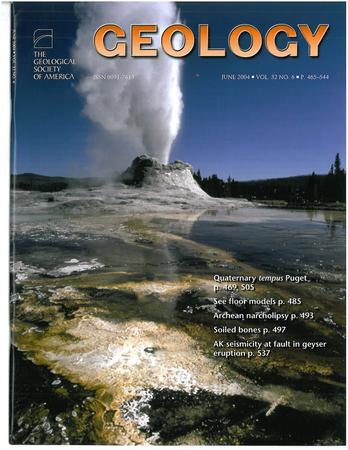地球上层软流圈内低速带的榴辉岩海洋地壳融化
IF 4.6
1区 地球科学
Q1 GEOLOGY
引用次数: 0
摘要
浅层软流层中的低速带对地球动力学至关重要,与部分熔体的存在有着广泛的联系。地幔橄榄岩熔融形成的初期熔体具有很强的流动性,往往会迅速脱离其源头;然而,LVZ如何延伸到部分融化开始的深度仍然是一个谜。在这里,我们发现了一套原始的低镁玄武岩,它们来自LVZ内约200公里处的榴辉化海洋地壳,为LVZ的形成提供了一个令人信服的场景。与洋中脊玄武岩相比,这些原始玄武岩表现出较重的Fe同位素和较轻的Ca-Mo-O同位素,表明它们起源于榴辉化的海洋地壳,而不是橄榄岩。这突出了一个事实,即海洋地壳再循环进入地幔,可以融化形成原始的贫镁和富硅熔体。由于其相对较高的密度和粘度,这些熔体表现出低流动性,并在深度约150 - 200 km处积聚,在软流层内形成一个低速层。本文章由计算机程序翻译,如有差异,请以英文原文为准。
Melting of eclogitic oceanic crust for the low-velocity zone within Earth’s upper asthenosphere
The low-velocity zone (LVZ) in shallow asthenosphere is crucial for Earth’s geodynamics and is widely linked to the presence of partial melts. Incipient melts from mantle peridotite melting are highly mobile and tend to quickly escape from their sources; however, it remains enigmatic how the LVZ can extend to the depths where partial melting initiates. Here, we identify a suite of primitive low-MgO basalts derived from an eclogitized oceanic crust at ∼200 km within the LVZ, providing a compelling scenario for the LVZ formation. These primitive basalts exhibit significantly heavier Fe isotopes and lighter Ca-Mo-O isotopes compared to mid-ocean-ridge basalts, indicating that they originated from eclogitized oceanic crust rather than peridotite. This highlights the fact that oceanic crust recycled into the mantle can melt to form primitive Mg-poor and Si-rich melts. Given their relatively high density and viscosity, these melts show low-mobility and accumulate at depths of ∼150−200 km, forming a low-velocity layer within the asthenosphere.
求助全文
通过发布文献求助,成功后即可免费获取论文全文。
去求助
来源期刊

Geology
地学-地质学
CiteScore
10.00
自引率
3.40%
发文量
228
审稿时长
6.2 months
期刊介绍:
Published since 1973, Geology features rapid publication of about 23 refereed short (four-page) papers each month. Articles cover all earth-science disciplines and include new investigations and provocative topics. Professional geologists and university-level students in the earth sciences use this widely read journal to keep up with scientific research trends. The online forum section facilitates author-reader dialog. Includes color and occasional large-format illustrations on oversized loose inserts.
 求助内容:
求助内容: 应助结果提醒方式:
应助结果提醒方式:


